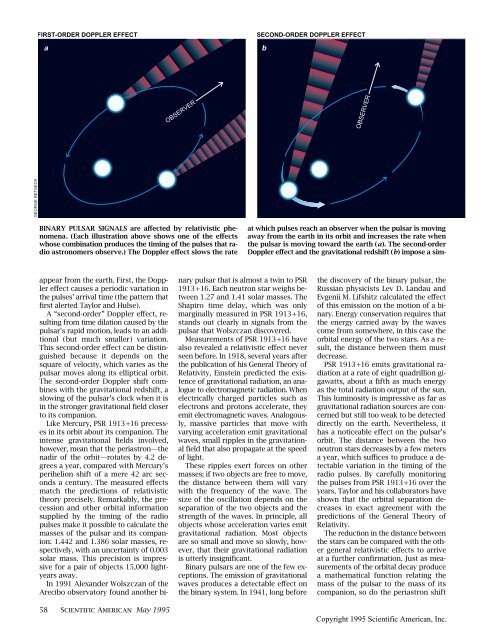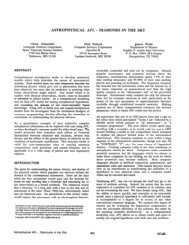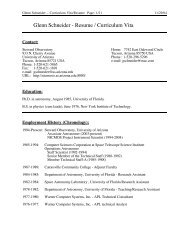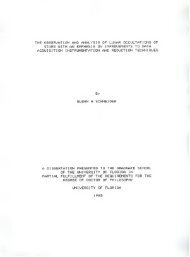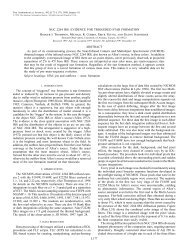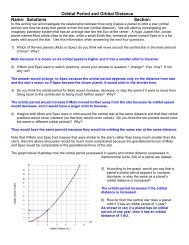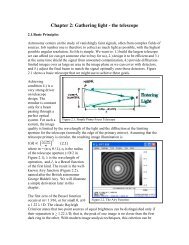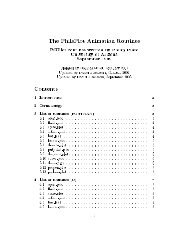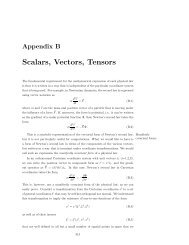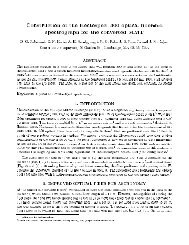Binary Neutron Stars - Scientific American Digital
Binary Neutron Stars - Scientific American Digital
Binary Neutron Stars - Scientific American Digital
You also want an ePaper? Increase the reach of your titles
YUMPU automatically turns print PDFs into web optimized ePapers that Google loves.
FIRST-ORDER DOPPLER EFFECT<br />
a<br />
SECOND-ORDER DOPPLER EFFECT<br />
b<br />
OBSERVER<br />
OBSERVER<br />
GEORGE RETSECK<br />
BINARY PULSAR SIGNALS are aÝected by relativistic phenomena.<br />
(Each illustration above shows one of the eÝects<br />
whose combination produces the timing of the pulses that radio<br />
astronomers observe.) The Doppler eÝect slows the rate<br />
at which pulses reach an observer when the pulsar is moving<br />
away from the earth in its orbit and increases the rate when<br />
the pulsar is moving toward the earth (a). The second-order<br />
Doppler eÝect and the gravitational redshift (b) impose a sim-<br />
58 SCIENTIFIC AMERICAN May 1995<br />
appear from the earth. First, the Doppler<br />
eÝect causes a periodic variation in<br />
the pulsesÕ arrival time (the pattern that<br />
Þrst alerted Taylor and Hulse).<br />
A Òsecond-orderÓ Doppler eÝect, resulting<br />
from time dilation caused by the<br />
pulsarÕs rapid motion, leads to an additional<br />
(but much smaller) variation.<br />
This second-order eÝect can be distinguished<br />
because it depends on the<br />
square of velocity, which varies as the<br />
pulsar moves along its elliptical orbit.<br />
The second-order Doppler shift combines<br />
with the gravitational redshift, a<br />
slowing of the pulsarÕs clock when it is<br />
in the stronger gravitational Þeld closer<br />
to its companion.<br />
Like Mercury, PSR 1913+16 precesses<br />
in its orbit about its companion. The<br />
intense gravitational Þelds involved,<br />
however, mean that the periastronÑthe<br />
nadir of the orbitÑrotates by 4.2 degrees<br />
a year, compared with MercuryÕs<br />
perihelion shift of a mere 42 arc seconds<br />
a century. The measured eÝects<br />
match the predictions of relativistic<br />
theory precisely. Remarkably, the precession<br />
and other orbital information<br />
supplied by the timing of the radio<br />
pulses make it possible to calculate the<br />
masses of the pulsar and its companion:<br />
1.442 and 1.386 solar masses, respectively,<br />
with an uncertainty of 0.003<br />
solar mass. This precision is impressive<br />
for a pair of objects 15,000 lightyears<br />
away.<br />
In 1991 Alexander Wolszczan of the<br />
Arecibo observatory found another binary<br />
pulsar that is almost a twin to PSR<br />
1913+16. Each neutron star weighs between<br />
1.27 and 1.41 solar masses. The<br />
Shapiro time delay, which was only<br />
marginally measured in PSR 1913+16,<br />
stands out clearly in signals from the<br />
pulsar that Wolszczan discovered.<br />
Measurements of PSR 1913+16 have<br />
also revealed a relativistic eÝect never<br />
seen before. In 1918, several years after<br />
the publication of his General Theory of<br />
Relativity, Einstein predicted the existence<br />
of gravitational radiation, an analogue<br />
to electromagnetic radiation. When<br />
electrically charged particles such as<br />
electrons and protons accelerate, they<br />
emit electromagnetic waves. Analogously,<br />
massive particles that move with<br />
varying acceleration emit gravitational<br />
waves, small ripples in the gravitational<br />
Þeld that also propagate at the speed<br />
of light.<br />
These ripples exert forces on other<br />
masses; if two objects are free to move,<br />
the distance between them will vary<br />
with the frequency of the wave. The<br />
size of the oscillation depends on the<br />
separation of the two objects and the<br />
strength of the waves. In principle, all<br />
objects whose acceleration varies emit<br />
gravitational radiation. Most objects<br />
are so small and move so slowly, however,<br />
that their gravitational radiation<br />
is utterly insigniÞcant.<br />
<strong>Binary</strong> pulsars are one of the few exceptions.<br />
The emission of gravitational<br />
waves produces a detectable eÝect on<br />
the binary system. In 1941, long before<br />
the discovery of the binary pulsar, the<br />
Russian physicists Lev D. Landau and<br />
Evgenii M. Lifshitz calculated the eÝect<br />
of this emission on the motion of a binary.<br />
Energy conservation requires that<br />
the energy carried away by the waves<br />
come from somewhere, in this case the<br />
orbital energy of the two stars. As a result,<br />
the distance between them must<br />
decrease.<br />
PSR 1913+16 emits gravitational radiation<br />
at a rate of eight quadrillion gigawatts,<br />
about a Þfth as much energy<br />
as the total radiation output of the sun.<br />
This luminosity is impressive as far as<br />
gravitational radiation sources are concerned<br />
but still too weak to be detected<br />
directly on the earth. Nevertheless, it<br />
has a noticeable eÝect on the pulsarÕs<br />
orbit. The distance between the two<br />
neutron stars decreases by a few meters<br />
a year, which suÛces to produce a detectable<br />
variation in the timing of the<br />
radio pulses. By carefully monitoring<br />
the pulses from PSR 1913+16 over the<br />
years, Taylor and his collaborators have<br />
shown that the orbital separation decreases<br />
in exact agreement with the<br />
predictions of the General Theory of<br />
Relativity.<br />
The reduction in the distance between<br />
the stars can be compared with the other<br />
general relativistic eÝects to arrive<br />
at a further conÞrmation. Just as measurements<br />
of the orbital decay produce<br />
a mathematical function relating the<br />
mass of the pulsar to the mass of its<br />
companion, so do the periastron shift<br />
Copyright 1995 <strong>Scientific</strong> <strong>American</strong>, Inc.


